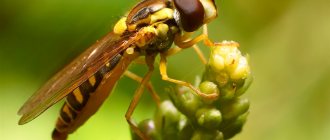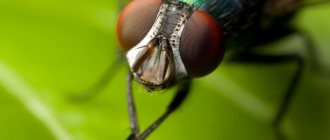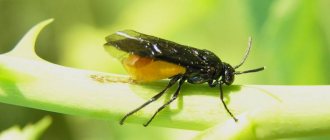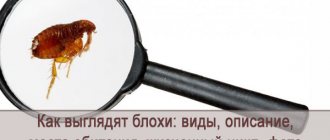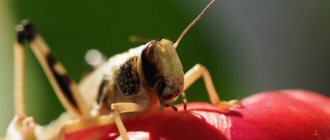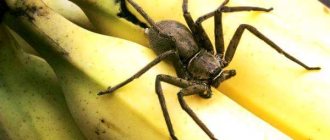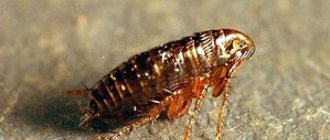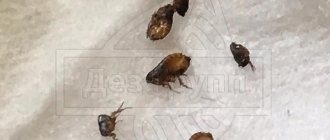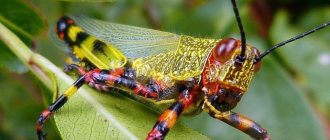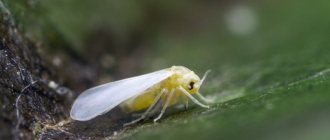Author: Elena N. https://floristics.info/ru/index.php?option=com_contact&view=contact&id=19 Category: Plant Pests Published: June 13, 2018Last edits: October 30, 2020
Moths (lat. Geometridae), or surveyors , are a large family of butterflies, numbering more than 2,000 genera and about 23,000 species. For garden and vegetable plants, the greatest danger is from moth caterpillars, which eat both cultivated and wild plants. Most often, in our climate, we find such representatives of the family as the pine and winter moths, the skinned moth and the gooseberry moth, or gooseberry.
Botanical description
The moth or surveyor is part of the Butterfly family, which has a huge number of species.
The butterfly is called a moth for the similarity of the way its caterpillar moves with a span, that is, a hand. The scientific name Geometridae is translated from Greek as “land surveyor,” which is also associated with the peculiarity of movement.
The moth, as seen in the photo, looks like a small or medium-sized butterfly with an elongated thin body and two pairs of wings - the upper ones in the shape of a triangle and the lower ones rounded. The wingspan of the moth depends on the type of butterfly and varies from 9–50 mm (usually 30). In females, the lower wings reach the end of the abdomen, while in the male they protrude slightly beyond it.
The coloring of the wings of most moths is protective, which gives them the opportunity to remain unnoticed on tree trunks and branches.
At rest, the moth folds its wings parallel to its body. Some butterflies lift them up and press them against each other. Both positions make them look like a folded piece of paper, which makes for good camouflage.
The moth has no eyes; the antennae of males are thread-like, while those of females are feathery or comb-like. The spiral proboscis is not well developed, the limbs are thin.
Caterpillars have a thin, long body with two underdeveloped pairs of legs, which are located in the middle part of the abdomen.
This structure determines the characteristic way of movement of the caterpillar - resting on the thoracic legs, it bends and lifts the middle part of the body and tightens the hind limbs. Then, resting his hind limbs, he stretches out the front part of the body.
Interesting! The presence of well-developed muscles allows the caterpillar to take a vertical position, standing on its hind legs.
Development and body structure
All individuals, regardless of species, have the following common structural features:
- Size is average or below average.
- The front wings are wide and triangular in shape.
- The lower ones are small, with an adnexal growth at the base.
- They have a powerful proboscis that allows them to drink plant nectar.
- The wings of females are smaller than those of males or absent altogether.
- Depending on the region where they live, they fly in the first half of spring or the second half of autumn.
- The color of most species has a protective color scheme, allowing them to be well camouflaged in their habitat.
We invite you to familiarize yourself with House plants - the most beautiful and popular (50 photos)
Lifestyle
The moth's weak wings do not allow it to make long flights, so this butterfly moves short distances and mainly in the dark. Some species fly during the day, but only in dry, windless weather.
Interesting! The females of some species of moths do not fly at all, which greatly facilitates the fight against them.
Throughout its short life, the butterfly feeds on flower nectar or does not eat at all (this depends on the species).
After mating, the moth lays elongated oval eggs on the bark or vegetative parts of fruit and ornamental plants. The larvae hatching from the eggs begin to actively devour green buds and leaves, and by the time of pupation they descend to the ground. This pest overwinters in a pupa, from which a butterfly emerges in the spring, after which the process is repeated again.
Habitats
The birch moth is a very numerous species. Its representatives can be found almost throughout Europe. The only exception is the Far North, since the climate prevailing there is completely unsuitable for her way of life. The same rule applies to Russian lands.
It should be understood that trees are extremely important for the survival of this insect. Therefore, it tries to settle in those areas where there is excellent access to them. The ideal environment is fruit plantations or forests. However, if there are none, then the birch moth can easily make do with a city park or public garden.
Types of moths
Among the variety of moths, not all are harmful. Several moth pests can be found in the Russian Federation.
Sosnovaya
Gray wings with a red tint, decorated with zigzags and small spots of white, black, and brown, make this moth inconspicuous against the background of tree bark. During the development period, caterpillars actively devour needles, which causes significant damage to coniferous forests, especially young plantings.
Berezovaya
Black spots on the wings allow this butterfly to remain unnoticed, blending in with the trunks of birch trees. Young caterpillars feed not only on birch leaves. They also like hazel and alder.
Black
The wings of this butterfly are black with a thin white edge along the upper edge. The caterpillar's body is green and velvety. Basically, these pests eat the leaves of chestnut trees, but they do not refuse other green spaces.
Fir
Thanks to its grayish wings with wavy lines, the fir moth on plants can be mistaken for a piece of a dry branch. This pest feeds on fir needles, but on occasion it can also devour other bushes and trees.
Gooseberry
A multi-colored butterfly whose white wings are decorated with alternating black and yellow stripes. The caterpillar of this moth also has a beautiful coloration.
The gooseberry moth causes trouble to gardeners more than its other relatives. The fact is that the caterpillar’s list of victims includes not only gooseberry bushes, but also stone fruit trees.
Winter
An inconspicuous butterfly with black lines on grayish wings, called the winter moth, is no less dangerous for fruit and ornamental crops than the gooseberry moth. It causes great damage to all garden plants, eating away buds and young seeds from the inside.
Ripped off
A dark brown, cream or light green butterfly whose caterpillars damage almost all types of deciduous trees, as well as fruit and ornamental shrubs. The result of the activity of the peeler is lacerations on the leaf blades of plants.
Mulberry moth
Mulberry leaves are considered the favorite delicacy of the mulberry butterfly caterpillar. In the absence of such, it will feed on the leaves and buds of stone fruit crops.
Tree Defiler
The caterpillar of the birch moth butterfly is one of the most dangerous pests living on the territory of the Russian Federation. Having hatched from the egg, they begin to eat everything that comes along the way, be it leaves, buds, buds, flowers or fruits. And given their number, it is not difficult to guess that literally in one day they can destroy a good part of the greenery on a tree.
Therefore, gardeners try to treat their trees in advance so that they are not attacked by omnivorous caterpillars. In addition, in this difficult struggle, some species of birds come to the aid of people. After all, if adult butterflies are protected by camouflage color, then their offspring are easier and more nutritious prey.
Harm of the moth
It is not the moth butterfly itself that poses a danger to the garden, but its caterpillar, which actively devours both generative and vegetative parts of the plant and is capable of infecting large areas of green spaces in a short time.
The result of the caterpillars' activity is:
- deterioration in fruit quality;
- decrease in yield;
- decreased resistance to cold and disease;
- deterioration of ornamental plants.
To save your garden from this pest, you need to know how to get rid of butterflies and moth caterpillars.
Prevention
Preventive control methods include:
- destruction of fallen leaves at the planting site;
- digging up soil where crops or trees grow;
- timely watering and care of grown crops;
- periodic treatment with medicinal solutions.
Despite the fact that the larva of the moth butterfly has its significance in the biogeocenosis, it is desirable to minimize the volume of its population. This is due to the fact that in most cases the larva of the moth butterfly occupies not the most attractive ecological niche - a parasitic one. Various birds and animals also feed on them, but their strength is often not enough to maintain the population within acceptable limits.
Ways to fight
There are 4 methods of combating moths - agrotechnical, mechanical, biological and chemical. A competent combination of all four methods helps to permanently cleanse the garden of this pest.
Agrotechnical
The list of agricultural activities includes:
- systematic examination of the vegetative parts of trees and shrubs in order to identify pupae and caterpillars;
- regular loosening of the soil in spring and autumn in the root zone of trees and shrubs. This helps destroy pupae overwintering in the soil;
- removing moss deposits from the stems, as well as dead parts of the bark (the removal sites are treated with a solution of copper sulfate);
- spring and autumn whitewashing of trunks of bushes and trees.
Mechanical
The most labor-intensive method of combating moths, which involves:
- manual collection of pupae, caterpillars, and spider nests in which butterflies gather to winter;
- use of catch belts of different designs.
The chemical method is the treatment of plants with chemicals, and the biological method is the attraction of natural enemies of caterpillars - birds, riders, and tahina flies - into the garden. In order to attract the latter, decorative onions or clover are planted on the site.
The list of sanitary measures also includes the treatment of vegetative parts of plants and soil in the root zone with biological preparations.
What stages does it go through?
The development of the moth includes several stages, each of which is described in the table.
| Imago | The butterfly is small or medium in size. The body is slim. Some individuals are able to curl up and resemble a dry leaf. Unlike females, males always have developed wings and can fly. |
| Egg | The egg has an oval shape. The shell is oblong. Color changes as it develops. |
| Larva | The caterpillar has no villi. When moving, the back of the body is pulled towards the front. The insect has a peculiar color that helps to camouflage itself. The larvae camouflage themselves under foliage or tree bark. |
| Doll | At a certain point, the caterpillar begins to pupate. The insect is in the ground at this time and can either have a cocoon or be without it. The pupae are green, yellow or gray in color. |
Individuals go through all stages of development. Insects are capable of dying prematurely only under unfavorable conditions or after interacting with enemies.
From this video you will learn more about the caterpillars of this butterfly:
Pest control products
In the process of fighting voracious caterpillars, both ready-made store-bought preparations and folk remedies for moths are used.
Biological and chemical preparations
It is easier to prevent an invasion of caterpillars than to get rid of them later. To do this, in the spring (before flowering), trees and bushes are treated with insecticides (Aktellik, Karbofos, Zolon, etc.)
If there is an urgent need to spray plants during flowering or fruiting, for example, if there are too many caterpillars, only biological agents such as Bitoxibacillin, Fitoverm, etc. can be used to treat moths.
Folk remedies
Compared to chemicals, homemade products are less effective, but also less toxic. Therefore, if the situation is not critical, you can use the following to destroy the moth:
Tomato tops. 1 kg of fresh tops is poured with water and left to infuse for 24 hours. Then cook it all over low heat for a couple of hours and filter. The cooled product is used for spraying fruit and ornamental crops.
Spurge. Fresh grass is poured with water so that it covers it completely, and left for 2-3 days. The finished infusion is filtered through cheesecloth and sprayed on the trees.
Hot pepper. 10 pieces. Finely chop the pepper, add water (about 1.5 liters) and cook for 1 hour. The finished broth is left for 2 days, then filtered and used for processing garden crops.
By the same principle, you can use burdock leaves, tansy and wormwood. Treatment with herbal remedies is absolutely safe for human health, so it can be carried out an unlimited number of times.
The moth, if not dealt with, can cause great harm to fruit and ornamental plants. Properly organized plant care, which includes preventive treatment of garden crops and timely destruction of pests if they appear, will help prevent trouble.
References
- ^ a b
Raj, David W. (2005).
"The Beauty of Kettlewell's Classic Experimental Demonstration of Natural Selection." Bioscience
.
55
(4): 369–375. Doi:10.1641 / 0006-3568 (2005) 055 [0369: TBOKCE] 2.0.CO; 2. - ^ a b c
Majerus, Michael E. N. (2008).
"Industrial melanism in the birch moth, Biston betularia: a wonderful teaching example of Darwinian evolution in action" (PDF). Evolution: Education and Propaganda
.
2
(1): 63–74. Doi:10.1007/s12052-008-0107-y. S2CID 25407417. - ^ a b
Rice, Stanley A. (2007).
Encyclopedia of Evolution
. New York: Facts on File. paragraph 308. ISBN 978-1-4381-1005-9. - M. E. N. Majerus (1998). Melanism: Evolution in Action
. Oxford University Press. ISBN 978-0-19-854983-3. - Clarke, CA.; Mani, G. S.; Wynn, G. (1985). "Evolution in reverse: clean air and moths." Biological Journal of the Linnean Society
.
26
(2): 189–199. Doi:10.1111/j.1095-8312.1985.tb01555.x. - Majerus, Michael E. N. (2008). "Industrial melanism in the birch moth, Biston Betularia
: An excellent teaching example of Darwinian evolution in action."
Evolution: Education and Propaganda
.
2
(1): 63–74. Doi:10.1007/s12052-008-0107-y. - ^ a b c
Miller, Ken (1999).
Moth: Update - ^ a b
Cook, L.M.;
Grant, B.S.; Saccheri, I.J.; Mallett, James (2012). "Selective Predation of the Plumed Moth by Birds: Michael Majerus's Latest Experiment." Letters on Biology
.
8
(4): 609–612. Doi:10.1098/rsbl.2011.1136. PMC 3391436. PMID 22319093. - Berry, R. J. (1990). "Industrial melanism and the moth (Biston betularia (L.))". Biological Journal of the Linnean Society
.
39
(4): 301–322. Doi:10.1111/j.1095-8312.1990.tb00518.x. - Saccheri, I.J.; Rousset, F.; Watts, P.C.; Brakefield, P. M.; Cook, L. M. (2008). "Selection and gene flow in a declining flock of melanic moths." Proceedings of the National Academy of Sciences
.
105
(42):16212–16217. Bibcode:2008PNAS..10516212С. doi:10.1073/pnas.0803785105. PMC 2571026. PMID 18854412. - Neal, Dick (2004). Introduction to Population Biology
(Reprint ed.). Cambridge: Cambridge University Press. paragraph 171. ISBN 9780521532235. - Edleston, R. S. (1864). "[Untitled]". Entomologist
.
2
: 150. Cite uses a generic title (Help) - ^ a b
Hart, Adam J.;
Stafford, Richard; Smith, Angela L.; Goodenough, Anne E. (2010). "Evidence for Modern Evolution during Darwin's Lifetime" (PDF). Current Biology
.
20
(3): R95. doi:10.1016/j.cub.2009.12.010. PMID 20144776. S2CID 31093691. - Farne, A. B. (18 November 1878). “Farne, A.B. To Darwin K.R., Letter 11747 about Darwin's correspondence project." Darwin's Papers
. Manuscript Room, Cambridge University Library, West Road, Cambridge, England. DAR 164: 26. - "How an unusual letter to Darwin discovered industrial melanism in moths." Scientific focus
. February 27, 2022. Retrieved June 16, 2022. - Steward, R. C. (1977). “Industrial and non-industrial melanism in the birch moth. Biston Betularia
(L.) ".
Ecological entomology
.
2
(3): 231–243. Doi:10.1111/j.1365-2311.1977.tb00886.x. S2CID 85624115. - ^ a b c
Cook, L. M. (2003).
"The Rise and Fall of the Carbonarian Form of the Peppered Moth". Biology Quarterly
.
78
(4):399–417. Doi:10.1086/378925. PMID 14737825. S2CID 26831926. - ^ a b c d
Majerus, Michael E. N. (August 2007). "The Moth: Evidence for Darwinian Evolution" (PDF). Archived from the original (PDF) on June 15, 2011. Retrieved September 9, 2007. - Haldane, J. B. S. (1924). Mathematical theory of natural and artificial selection
. - Bowler, Peter J. (2003). Evolution: The History of an Idea, 3rd edition
. University of California Press. pp.331–332. ISBN 0-520-23693-9. - Grant, B. S. (2004). "Allelic melanism in American and British hips." Journal of Heredity
.
95
(2):97–102. Doi:10.1093/jhered/esh022. PMID 15073224. - van't Hof, Arjen E.; Edmonds, Nicola; Dalikova, Martina; Marek, Frantisek; Saccheri, Ilic J. (May 20, 2011). "Industrial melanism in British feathered moths has a single and recent mutational origin." The science
.
332
(6032):958–960. Bibcode:2011Sciences... 332..958В. Doi:10.1126/science.1203043. PMID 21493823. S2CID 24400858 - via JSTOR. - ^ a b c d e
van't Hof, Arjen E.;
Campagne, Pascal; Rigden, Daniel J.; Jung, Carl J.; Lingley, Jessica; Quail, Michael A.; Hall, Neil; Darby, Alistair; Saccheri, Ilic J. (June 2, 2016). "The industrial melanism mutation in the British moth is a transmissible element." Nature
.
534
(7605): 102–117. Bibcode:2016Natura.534..102H. doi:10.1038/nature17951. PMID 27251284. - Dobzhansky, T. (1937). Genetics and the Evolutionary Process
. Columbia University Press. ISBN 0-231-08306-8. - Riley, P.A. (2013). "Proposed selective mechanism based on metal chelation in industrial melanic moths" (PDF). Biological Journal of the Linnean Society
.
109
(2):298–301. Doi:10.1111/bij.12062. - Fisher, R.A. (1933). "On the evidence against chemical induction of melanism in Lepidoptera". Proceedings of the Royal Society
B.
112
(778): 407–416. Bibcode:1933RSPSB.112..407F. doi:10.1098/rspb.1933.0018. - Kettlewell, G. B. D (1958). "Review of the frequencies of Biston betularia (L.) (Lep.) and its melanic forms in Great Britain." Heredity
.
12
(1): 51–72. Doi:10.1038/hdy.1958.4. - Sargent, T. D. (1968). "Mysterious moth: influence on the choice of background color of periocular scales." The science
.
159
(3810): 100–101. Bibcode:1968Sci...159..100S. Doi:10.1126/science.159.3810.100. PMID 5634373. S2CID 32124765. - Sargent, T. D. (1969). "Background selection of pale and melanic forms of the hidden moth, Phigalia titea (Cramer)." Nature
.
222
(5193):585–586. Bibcode:1969Natura.222..585С. Doi:10.1038/222585b0. S2CID 4202131. - Sargent, T. D.; Millar, C. D.; Lambert, D. (1988). "Chapter 9: The 'Classical' Explanation of Industrial Melanism: Assessing the Evidence." In Hecht, Max K.; Wallace, Bruce (ed.). Evolutionary Biology
.
23
. Plenum Press. ISBN 0306429772. - Coyne, Jerry A. (1998). “It’s not black and white. Review of Melanism: Evolution in Action
by Michael E. Majerus."
Nature
.
396
(6706): 35–36. Doi:10.1038/23856. - Kenny, Michael (22 October 2002). "On Dark Moths, People and Evolution." Chicago Tribune
. Retrieved December 10, 2014. - "Of Moths and Men." W. W. Norton & Company. Archived from the original on December 10, 2014. Retrieved December 10, 2014.
- Smith, Peter D. (11 May 2002). "Of Moths and Men: Intrigue, Tragedy and the Moth." The keeper
. Retrieved December 10, 2014. - "Moths and Men." Independent
. September 4, 2003. Retrieved December 10, 2014. - Dover, Gabby (2003). "Moth Hunters" EMBO Reports
.
4
(3): 235. doi:10.1038/sj.embor.embor778. PMC 1315906. - Grant, B.S. (2002), "The Sour Grapes of Wrath", Science
,
297
: 940–941, doi:10.1126/science.1073593, S2CID 161367302 - Majerus, Michael E. N. (2005). "The Moth: The Decline of Darwin's Apprentice." In Fellowes, Mark; Holloway, Graham; Rolf, Jens (ed.). Evolutionary ecology of insects
. Wallingford, Oxon: CABI Publishing. pp. 375–377. ISBN 978-1-84593-140-7. - Frack, Donald (April 16, 1999). "Evolution—April 1999: Moths and Creationists." Archived from the original on August 26, 2007. Retrieved August 26, 2007.
- Wells, J. (24 May 1999). “Reflections on birch moths; this classic story of evolution by natural selection needs to be revised." Scientist
.
13
(11): 13. - Wells, J. (2000). Icons of Evolution: Science or Myth?
Why Much of What We Say About Evolution Is Wrong . Regnery Press, Washington, DC, page 138 (book available at Iconsofevolution.com) - "Icon of Blackout: Chapter 7: Feathered Moths."
- Connor, Steve (25 August 2007). "The moth study confirms the classic 'test case' of Darwin's theory." Independent
. Archived from the original on October 7, 2008. Retrieved September 9, 2007. - Matzke, Nick (February 8, 2012). "Selective Predation of the Plumed Moth by Birds: Michael Majerus's Latest Experiment." Panda's thumb. Retrieved March 7, 2012.
- Coyne, Jerry (February 12, 2012). “The history of the hip is solid.” Why evolution is true. Retrieved March 7, 2012.
Pyadenitsa Photos
Diagnostic signs
Butterfly
– white with large black spots of irregular shape, wingspan 40-50 mm (45-62 mm). The wings are white, covered with numerous dark brown stripes; almost black specimens are found in industrial areas (industrial melanism). The fore wings are narrow, elongated towards the apex, with two, and the hind wings with one serrated stripe.
Caterpillars
– 45-55 mm long, large, brown, yellowish-green or gray, imitating the color of the substrate on which it is located; with a dark stripe on the back and large white warts on the 5th and 8th abdominal segments. The color varies greatly from brown to yellow-green, usually the color of birch branches. The head sticks out with the crown forward, oblique in front, heart-shaped, with a deep notch, so that the hemispheres have sharp tubercles (as if horned). Spiracles are rusty red. Aug. Sept.
Doll
– brown-red (dark brown), length 17-20 mm. The first pair of spiracles sits on large spiracular tubercles and the pupa appears eared.
Evolution of color or type of adaptation
The birch moth is capable of changing its color. The acquisition of this feature was influenced by external factors caused by human activity. The process of natural selection that caused the appearance of dark coloration is called industrial melanism.
Until the middle years of the 19th century, insects had white wings with black spots. Using this color scheme, butterflies were perfectly camouflaged on birch bark. They could also hide in lichens and enemies would not notice them. Later, colonies of moths of the same color began to appear near the large industrial centers of Europe and North America. The pests changed their main color to black.
Industrial melanism [ edit | edit code]
It is the most famous example of industrial melanism. Until the middle of the 19th century, all specimens of the birch moth collected by entomologists had white-grayish wings with dark spots ( morpha typica
), which provided a protective coloring on tree trunks.
Now many populations are polymorphic, they contain black melanistic forms - Biston betularia morpha carbonaria
.
The increase in the frequency of melanistic forms is a consequence of directed selection, the main driving factor of which is the selective consumption of butterfly individuals by birds. In forests around industrial plants and cities, tree trunks are often devoid of lichens and may be blackened by soot. In such areas the protective color is black, while in unpolluted areas the protective color is light spotted. A third form is also known, having a dark color intermediate between the melanistic and light forms of the birch moth - morpha insularia
. This type of coloration, like the melanistic one, dominates over the light one, however, apparently, it is determined not in one, but in several loci. Based on laboratory experiments, it was assumed that the alleles that control melanistic coloration have a pleiotropic effect, determining not only the color of the butterfly, but also its behavior (choice of background). However, this has not been confirmed by observations in nature.
